Donghao Luo
OracleAgent: A Multimodal Reasoning Agent for Oracle Bone Script Research
Oct 30, 2025Abstract:As one of the earliest writing systems, Oracle Bone Script (OBS) preserves the cultural and intellectual heritage of ancient civilizations. However, current OBS research faces two major challenges: (1) the interpretation of OBS involves a complex workflow comprising multiple serial and parallel sub-tasks, and (2) the efficiency of OBS information organization and retrieval remains a critical bottleneck, as scholars often spend substantial effort searching for, compiling, and managing relevant resources. To address these challenges, we present OracleAgent, the first agent system designed for the structured management and retrieval of OBS-related information. OracleAgent seamlessly integrates multiple OBS analysis tools, empowered by large language models (LLMs), and can flexibly orchestrate these components. Additionally, we construct a comprehensive domain-specific multimodal knowledge base for OBS, which is built through a rigorous multi-year process of data collection, cleaning, and expert annotation. The knowledge base comprises over 1.4M single-character rubbing images and 80K interpretation texts. OracleAgent leverages this resource through its multimodal tools to assist experts in retrieval tasks of character, document, interpretation text, and rubbing image. Extensive experiments demonstrate that OracleAgent achieves superior performance across a range of multimodal reasoning and generation tasks, surpassing leading mainstream multimodal large language models (MLLMs) (e.g., GPT-4o). Furthermore, our case study illustrates that OracleAgent can effectively assist domain experts, significantly reducing the time cost of OBS research. These results highlight OracleAgent as a significant step toward the practical deployment of OBS-assisted research and automated interpretation systems.
SwiftVideo: A Unified Framework for Few-Step Video Generation through Trajectory-Distribution Alignment
Aug 08, 2025Abstract:Diffusion-based or flow-based models have achieved significant progress in video synthesis but require multiple iterative sampling steps, which incurs substantial computational overhead. While many distillation methods that are solely based on trajectory-preserving or distribution-matching have been developed to accelerate video generation models, these approaches often suffer from performance breakdown or increased artifacts under few-step settings. To address these limitations, we propose \textbf{\emph{SwiftVideo}}, a unified and stable distillation framework that combines the advantages of trajectory-preserving and distribution-matching strategies. Our approach introduces continuous-time consistency distillation to ensure precise preservation of ODE trajectories. Subsequently, we propose a dual-perspective alignment that includes distribution alignment between synthetic and real data along with trajectory alignment across different inference steps. Our method maintains high-quality video generation while substantially reducing the number of inference steps. Quantitative evaluations on the OpenVid-1M benchmark demonstrate that our method significantly outperforms existing approaches in few-step video generation.
DVHGNN: Multi-Scale Dilated Vision HGNN for Efficient Vision Recognition
Mar 19, 2025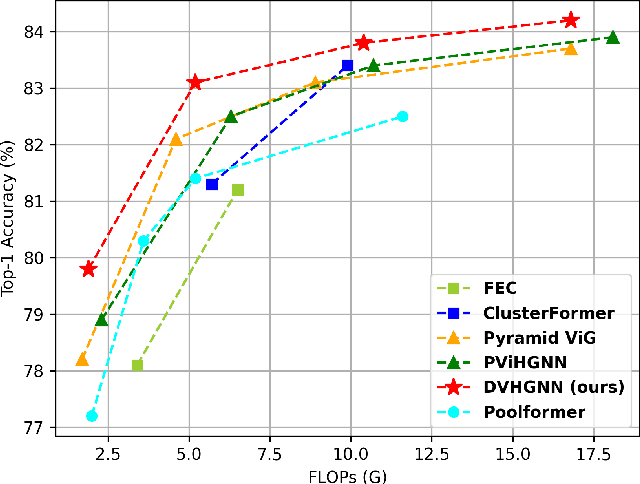

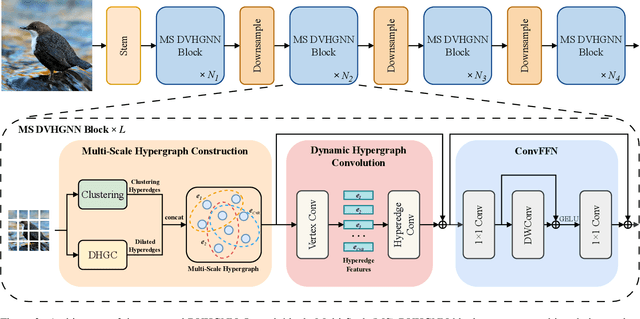
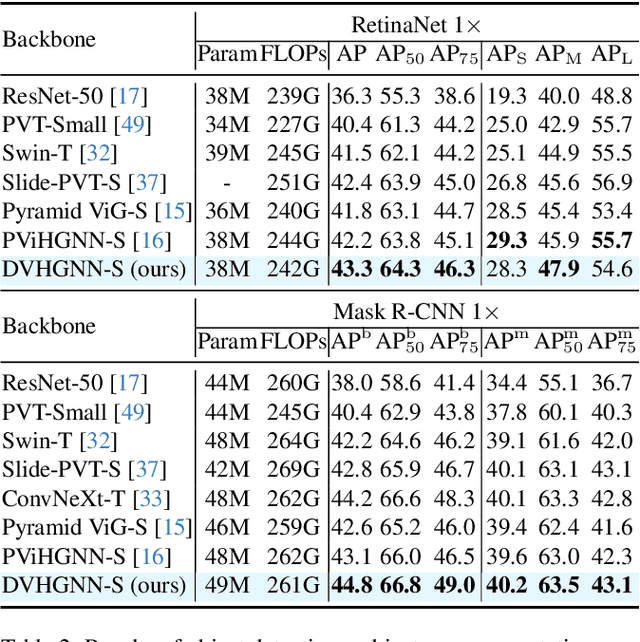
Abstract:Recently, Vision Graph Neural Network (ViG) has gained considerable attention in computer vision. Despite its groundbreaking innovation, Vision Graph Neural Network encounters key issues including the quadratic computational complexity caused by its K-Nearest Neighbor (KNN) graph construction and the limitation of pairwise relations of normal graphs. To address the aforementioned challenges, we propose a novel vision architecture, termed Dilated Vision HyperGraph Neural Network (DVHGNN), which is designed to leverage multi-scale hypergraph to efficiently capture high-order correlations among objects. Specifically, the proposed method tailors Clustering and Dilated HyperGraph Construction (DHGC) to adaptively capture multi-scale dependencies among the data samples. Furthermore, a dynamic hypergraph convolution mechanism is proposed to facilitate adaptive feature exchange and fusion at the hypergraph level. Extensive qualitative and quantitative evaluations of the benchmark image datasets demonstrate that the proposed DVHGNN significantly outperforms the state-of-the-art vision backbones. For instance, our DVHGNN-S achieves an impressive top-1 accuracy of 83.1% on ImageNet-1K, surpassing ViG-S by +1.0% and ViHGNN-S by +0.6%.
CrossVTON: Mimicking the Logic Reasoning on Cross-category Virtual Try-on guided by Tri-zone Priors
Feb 20, 2025



Abstract:Despite remarkable progress in image-based virtual try-on systems, generating realistic and robust fitting images for cross-category virtual try-on remains a challenging task. The primary difficulty arises from the absence of human-like reasoning, which involves addressing size mismatches between garments and models while recognizing and leveraging the distinct functionalities of various regions within the model images. To address this issue, we draw inspiration from human cognitive processes and disentangle the complex reasoning required for cross-category try-on into a structured framework. This framework systematically decomposes the model image into three distinct regions: try-on, reconstruction, and imagination zones. Each zone plays a specific role in accommodating the garment and facilitating realistic synthesis. To endow the model with robust reasoning capabilities for cross-category scenarios, we propose an iterative data constructor. This constructor encompasses diverse scenarios, including intra-category try-on, any-to-dress transformations (replacing any garment category with a dress), and dress-to-any transformations (replacing a dress with another garment category). Utilizing the generated dataset, we introduce a tri-zone priors generator that intelligently predicts the try-on, reconstruction, and imagination zones by analyzing how the input garment is expected to align with the model image. Guided by these tri-zone priors, our proposed method, CrossVTON, achieves state-of-the-art performance, surpassing existing baselines in both qualitative and quantitative evaluations. Notably, it demonstrates superior capability in handling cross-category virtual try-on, meeting the complex demands of real-world applications.
Exploring Real&Synthetic Dataset and Linear Attention in Image Restoration
Dec 05, 2024Abstract:Image Restoration aims to restore degraded images, with deep learning, especially CNNs and Transformers, enhancing performance. However, there's a lack of a unified training benchmark for IR. We identified a bias in image complexity between training and testing datasets, affecting restoration quality. To address this, we created ReSyn, a large-scale IR dataset with balanced complexity, including real and synthetic images. We also established a unified training standard for IR models. Our RWKV-IR model integrates linear complexity RWKV into transformers for global and local receptive fields. It replaces Q-Shift with Depth-wise Convolution for local dependencies and combines Bi-directional attention for global-local awareness. The Cross-Bi-WKV module balances horizontal and vertical attention. Experiments show RWKV-IR's effectiveness in image restoration.
DynamicControl: Adaptive Condition Selection for Improved Text-to-Image Generation
Dec 04, 2024



Abstract:To enhance the controllability of text-to-image diffusion models, current ControlNet-like models have explored various control signals to dictate image attributes. However, existing methods either handle conditions inefficiently or use a fixed number of conditions, which does not fully address the complexity of multiple conditions and their potential conflicts. This underscores the need for innovative approaches to manage multiple conditions effectively for more reliable and detailed image synthesis. To address this issue, we propose a novel framework, DynamicControl, which supports dynamic combinations of diverse control signals, allowing adaptive selection of different numbers and types of conditions. Our approach begins with a double-cycle controller that generates an initial real score sorting for all input conditions by leveraging pre-trained conditional generation models and discriminative models. This controller evaluates the similarity between extracted conditions and input conditions, as well as the pixel-level similarity with the source image. Then, we integrate a Multimodal Large Language Model (MLLM) to build an efficient condition evaluator. This evaluator optimizes the ordering of conditions based on the double-cycle controller's score ranking. Our method jointly optimizes MLLMs and diffusion models, utilizing MLLMs' reasoning capabilities to facilitate multi-condition text-to-image (T2I) tasks. The final sorted conditions are fed into a parallel multi-control adapter, which learns feature maps from dynamic visual conditions and integrates them to modulate ControlNet, thereby enhancing control over generated images. Through both quantitative and qualitative comparisons, DynamicControl demonstrates its superiority over existing methods in terms of controllability, generation quality and composability under various conditional controls.
Unveil Inversion and Invariance in Flow Transformer for Versatile Image Editing
Nov 26, 2024



Abstract:Leveraging the large generative prior of the flow transformer for tuning-free image editing requires authentic inversion to project the image into the model's domain and a flexible invariance control mechanism to preserve non-target contents. However, the prevailing diffusion inversion performs deficiently in flow-based models, and the invariance control cannot reconcile diverse rigid and non-rigid editing tasks. To address these, we systematically analyze the \textbf{inversion and invariance} control based on the flow transformer. Specifically, we unveil that the Euler inversion shares a similar structure to DDIM yet is more susceptible to the approximation error. Thus, we propose a two-stage inversion to first refine the velocity estimation and then compensate for the leftover error, which pivots closely to the model prior and benefits editing. Meanwhile, we propose the invariance control that manipulates the text features within the adaptive layer normalization, connecting the changes in the text prompt to image semantics. This mechanism can simultaneously preserve the non-target contents while allowing rigid and non-rigid manipulation, enabling a wide range of editing types such as visual text, quantity, facial expression, etc. Experiments on versatile scenarios validate that our framework achieves flexible and accurate editing, unlocking the potential of the flow transformer for versatile image editing.
Sonic: Shifting Focus to Global Audio Perception in Portrait Animation
Nov 25, 2024



Abstract:The study of talking face generation mainly explores the intricacies of synchronizing facial movements and crafting visually appealing, temporally-coherent animations. However, due to the limited exploration of global audio perception, current approaches predominantly employ auxiliary visual and spatial knowledge to stabilize the movements, which often results in the deterioration of the naturalness and temporal inconsistencies.Considering the essence of audio-driven animation, the audio signal serves as the ideal and unique priors to adjust facial expressions and lip movements, without resorting to interference of any visual signals. Based on this motivation, we propose a novel paradigm, dubbed as Sonic, to {s}hift f{o}cus on the exploration of global audio per{c}ept{i}o{n}.To effectively leverage global audio knowledge, we disentangle it into intra- and inter-clip audio perception and collaborate with both aspects to enhance overall perception.For the intra-clip audio perception, 1). \textbf{Context-enhanced audio learning}, in which long-range intra-clip temporal audio knowledge is extracted to provide facial expression and lip motion priors implicitly expressed as the tone and speed of speech. 2). \textbf{Motion-decoupled controller}, in which the motion of the head and expression movement are disentangled and independently controlled by intra-audio clips. Most importantly, for inter-clip audio perception, as a bridge to connect the intra-clips to achieve the global perception, \textbf{Time-aware position shift fusion}, in which the global inter-clip audio information is considered and fused for long-audio inference via through consecutively time-aware shifted windows. Extensive experiments demonstrate that the novel audio-driven paradigm outperform existing SOTA methodologies in terms of video quality, temporally consistency, lip synchronization precision, and motion diversity.
FitDiT: Advancing the Authentic Garment Details for High-fidelity Virtual Try-on
Nov 22, 2024



Abstract:Although image-based virtual try-on has made considerable progress, emerging approaches still encounter challenges in producing high-fidelity and robust fitting images across diverse scenarios. These methods often struggle with issues such as texture-aware maintenance and size-aware fitting, which hinder their overall effectiveness. To address these limitations, we propose a novel garment perception enhancement technique, termed FitDiT, designed for high-fidelity virtual try-on using Diffusion Transformers (DiT) allocating more parameters and attention to high-resolution features. First, to further improve texture-aware maintenance, we introduce a garment texture extractor that incorporates garment priors evolution to fine-tune garment feature, facilitating to better capture rich details such as stripes, patterns, and text. Additionally, we introduce frequency-domain learning by customizing a frequency distance loss to enhance high-frequency garment details. To tackle the size-aware fitting issue, we employ a dilated-relaxed mask strategy that adapts to the correct length of garments, preventing the generation of garments that fill the entire mask area during cross-category try-on. Equipped with the above design, FitDiT surpasses all baselines in both qualitative and quantitative evaluations. It excels in producing well-fitting garments with photorealistic and intricate details, while also achieving competitive inference times of 4.57 seconds for a single 1024x768 image after DiT structure slimming, outperforming existing methods.
VTON-HandFit: Virtual Try-on for Arbitrary Hand Pose Guided by Hand Priors Embedding
Aug 27, 2024
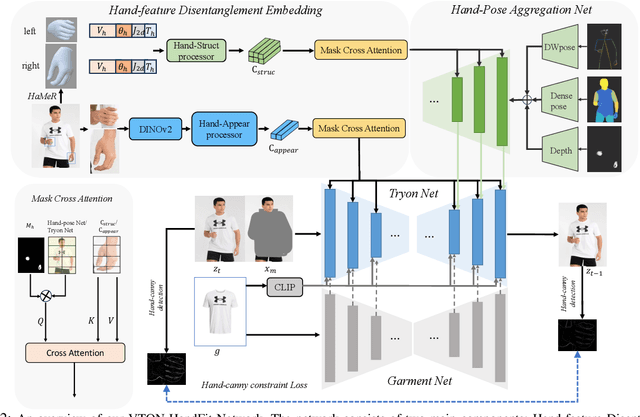

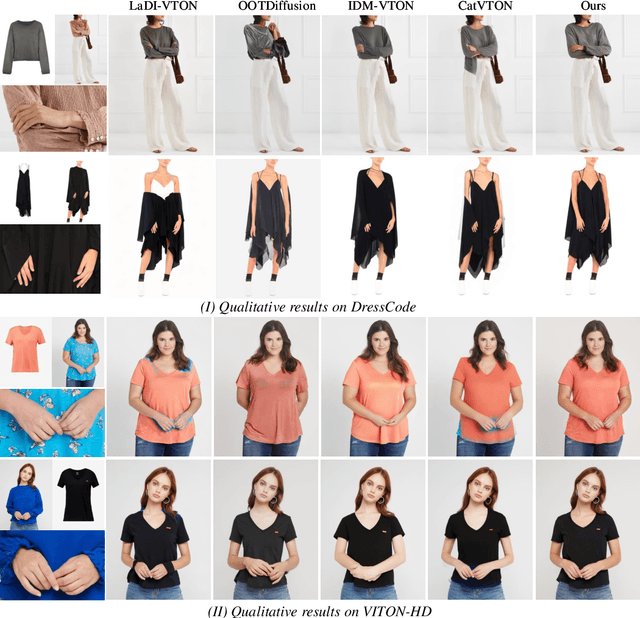
Abstract:Although diffusion-based image virtual try-on has made considerable progress, emerging approaches still struggle to effectively address the issue of hand occlusion (i.e., clothing regions occluded by the hand part), leading to a notable degradation of the try-on performance. To tackle this issue widely existing in real-world scenarios, we propose VTON-HandFit, leveraging the power of hand priors to reconstruct the appearance and structure for hand occlusion cases. Firstly, we tailor a Handpose Aggregation Net using the ControlNet-based structure explicitly and adaptively encoding the global hand and pose priors. Besides, to fully exploit the hand-related structure and appearance information, we propose Hand-feature Disentanglement Embedding module to disentangle the hand priors into the hand structure-parametric and visual-appearance features, and customize a masked cross attention for further decoupled feature embedding. Lastly, we customize a hand-canny constraint loss to better learn the structure edge knowledge from the hand template of model image. VTON-HandFit outperforms the baselines in qualitative and quantitative evaluations on the public dataset and our self-collected hand-occlusion Handfit-3K dataset particularly for the arbitrary hand pose occlusion cases in real-world scenarios. The Code and dataset will be available at \url{https://github.com/VTON-HandFit/VTON-HandFit}.
 Add to Chrome
Add to Chrome Add to Firefox
Add to Firefox Add to Edge
Add to Edge